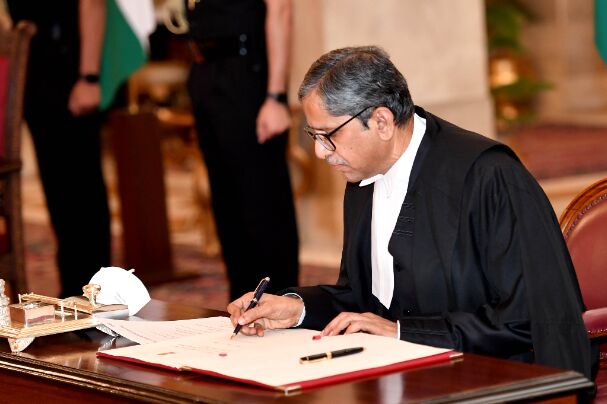Setting new trends

The oath-taking of nine Supreme Court judges has finally put an end to the two-year-long impasse in the appointment of judges to the vacant posts. The current Collegium — comprising Chief Justice NV Ramana, Justices UU Lalit, AM Khanwilkar, DY Chandrachud and L Nageswara Rao — has lived up to the hopes of bridging the widening gulf between the full strength and vacancies. With the appointment of nine judges in one go, the current strength now stands at 33 — leaving one post vacant. Oathing of the judges was in itself a historic moment as some novel positive trends were adopted during the process and new precedents were set. It is reassuring that the apex court has banked upon greater transparency by allowing live telecast of the proceedings for the first time as the new judges took oath in the Court's auditorium, rather than the conventional venue of CJI's courtroom. This certainly is a statement in action against the labels of 'closed-door' functioning of the Collegium. The best takeaway has been the greater gender inclusivity with the appointment of three female judges — Justice Hima Kohli, Justice BV Nagarathna and Justice Bela M Trivedi — to the Supreme Court. Justice BV Nagarathna is likely to become the first woman Chief Justice of India in 2027 for a brief period of one month. Including more women in judiciary will certainly improve the process of dealing with gender-sensitive cases related to rape, molestation and sexual assault to a certain extent. This has been a long-pending issue that needs to be addressed at the earliest. More importantly, the appointment of female judges should open floodgates for the future. With the oath of these three women judges, the total number of female judges in the Supreme Court has now reached four. While the appointments are a significant step forward, the ratio of 4 to 33 is still not very encouraging. The Indian judiciary needs not just small steps forward but leapfrogging. Unequal representation of women in the judiciary persists at all levels and branches. The appointment of Justice Fathima Beevi — the first woman SC judge — in 1989 had broken the 40-year long impasse then but remained a mere symbolic development. The male dominant judiciary has been conceding rather sluggishly the due space to the women judges since then. The appointment of a mere eleven women judges in a span of around 70 years might not be a feat to celebrate. The ratio of representation of women in High courts and other lower courts remains terribly bleak. Women judges don't even constitute 10 per cent of the total strength in High courts. There could be no reasonable explanation as to why the women — who are leaving their mark across all fields of work — are lagging behind in one of the top institutions of the nation. Apart from being a question of gender equality, the disproportionate representation is also an issue of sensitization of the judiciary towards cases involving the privacy of women across the nation. Another positive novel aspect of the current appointments has been the convergence between the judiciary and the Central government that has enabled this much-needed leap. The finesse with which NV Ramana-led Collegium engaged with the government to end the impasse has been commendable. The two fronts have historically been at odds with each other in matters relating to the appointment of judges under the Collegium system. The Second Judges Case (1993) had offered a different interpretation — against the First Judges Case (1882) — of the word 'consultation' on which the President appoints judges of the Supreme Court — implying that the consultation means concurrence. The Third Judges Case (1998) had, however, put some conditions on the part of the Chief Justice of India to be followed during the consultation process. The system, to a certain extent, provides a ground of resistance between the Collegium and the government. To make sure that appointments to the Supreme Court are made more consistently and a near-total strength is maintained at all times, perhaps the SC may look into streamlining the Collegium process in a way that leaves no space for ambiguities. Also, the current trend would make more sense if the same is trickled down to lower courts as well. The overburdened judiciary is a serious issue in the country and filling vacancies efficiently could solve much of the problem. The convergence between the government and the Collegium may have lots of lessons to offer, which should be taken promptly by all layers of the judiciary. Another important thing that cannot be missed out is the elevation of women judges to the Collegium, which remains constrained by the clause of seniority implied under the Second Judges Case. Nevertheless, the positive takeaways from the recent appointments need to be taken further to augment our judicial system.



